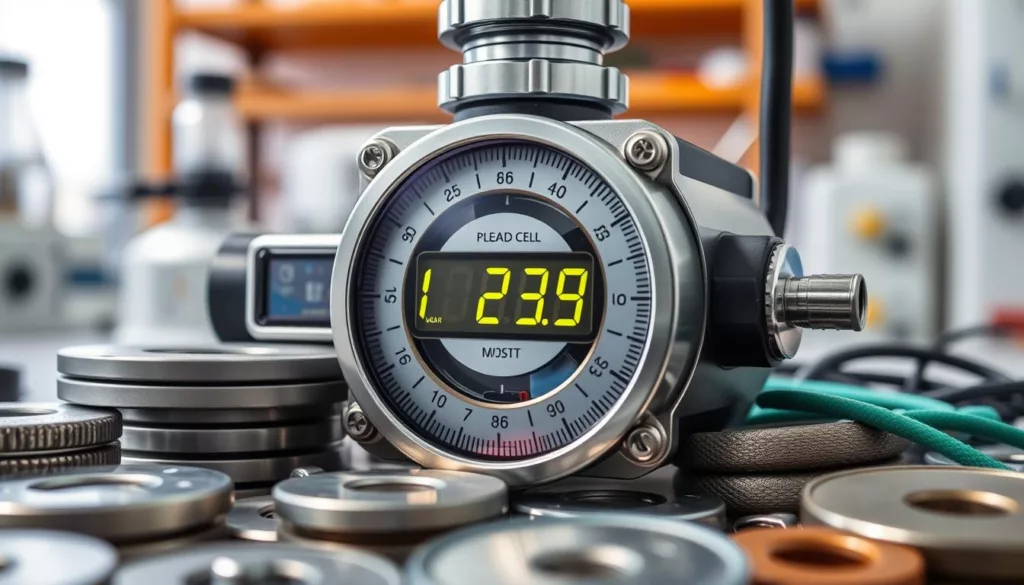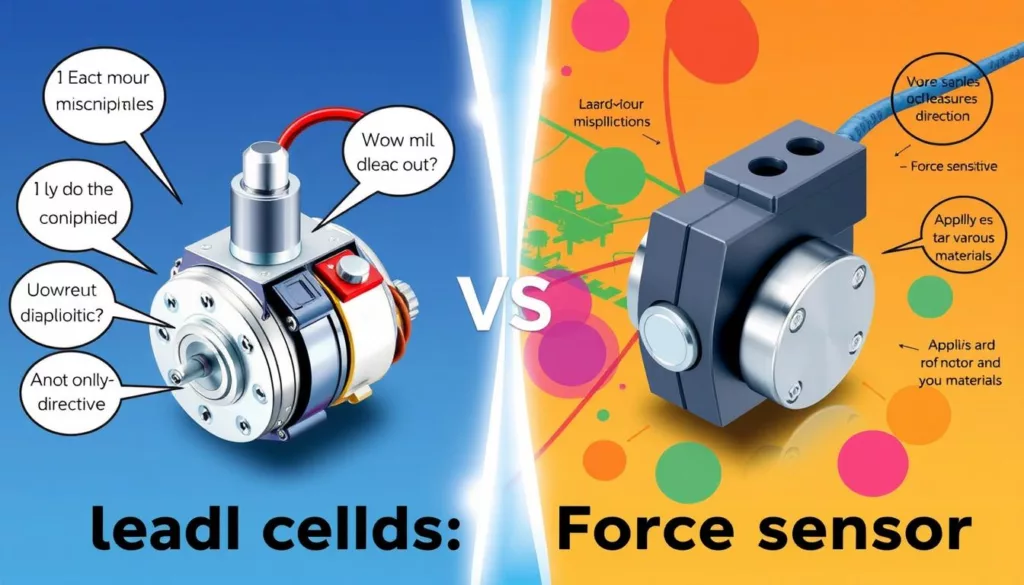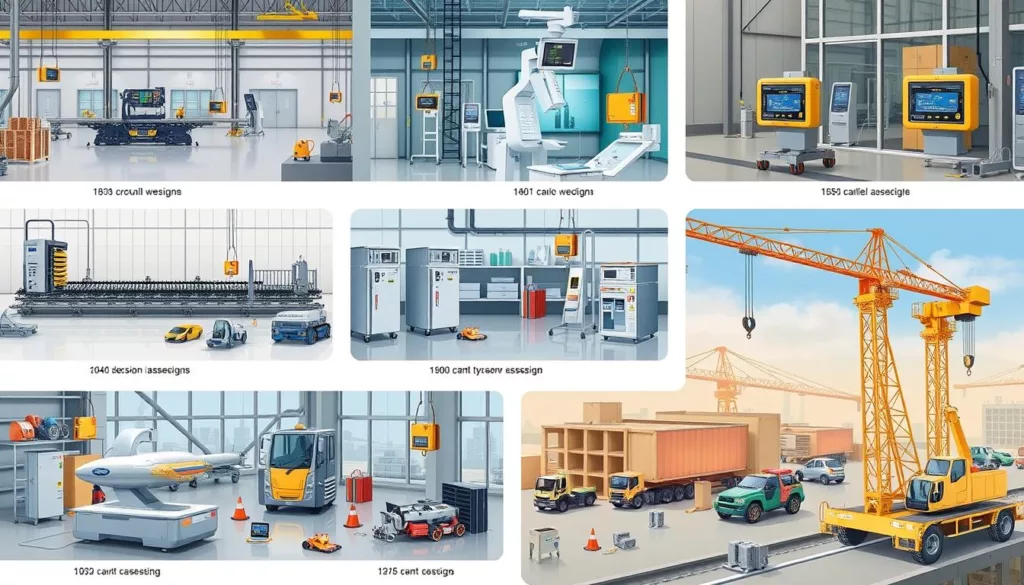It’s important for industrial experts to know the differences between load cells and force sensors. These tools help improve measurement accuracy and work efficiency. They have different uses, but sometimes they do similar jobs. We’ll look at how each works and where they’re used.
This will help engineers and technical leaders choose the right sensor for their needs.
Key Takeaways
- Load cells are mainly for measuring weight, while force sensors measure applied force.
- The way they work is quite different.
- Load cells are used a lot in weighing systems. Force sensors are common in robotics and automation.
- Accuracy and response time vary by sensor type.
- Knowing these differences is key to picking the right technology for your job.
Understanding Load Cells
Load cells are key in industrial sensing and measurement. They turn force or weight into electrical signals. This makes them reliable and effective.
Definition and Functionality
Load cells measure static and dynamic forces with great accuracy. They use load cell technology to change physical changes into electrical signals. This is vital for controlling industrial processes.
Types of Load Cells
There are many types of load cells, each for different needs. The main ones are:
- Strain gauge load cells: Great for many industrial uses.
- Hydraulic load cells: Best for heavy loads, using fluid pressure.
- Pneumatic load cells: Good for non-contact measurements, using gas pressure.
Each type has its own strengths. Knowing these helps pick the right load cell for the job, which is important for precision.
Applications of Load Cells
Load cells are used in many fields. They are versatile and important in:
- Manufacturing: Crucial for checking production and quality.
- Aerospace: Used for weighing aircraft parts.
- Automotive: Helps in vehicle testing and quality checks.
- Inventory management: Accurate for stock levels and logistics.
Load cells give real-time feedback, improving efficiency. They play a big role in making processes better in many industries. For more on similar tech, see this link.
Understanding Force Sensors
Force sensors are key in many industries. They measure the force on an object and turn it into an electrical signal. These devices use different technologies like piezoelectric, capacitive, and resistive. This helps them accurately sense the applied forces.
Definition and Functionality
A force sensor definition is a device that detects force and shows it in a measurable way. With force sensing technology, these sensors give important data. This data helps with precise control and measurement in tough applications.
Their ability to give real-time feedback makes them very useful in many places.
Types of Force Sensors
There are several main types of force sensors:
- Piezoelectric Force Sensors: Great for dynamic force needs.
- Resistive Force Sensors: Best for static measurements, reliable in many conditions.
- Capacitive Force Sensors: Good for measuring big forces with little drift, used in many industries.
Choosing the right type depends on the application. It ensures the sensor works well in its specific use.
Applications of Force Sensors
Force sensors have many uses in today’s industry. They are very important in robotics and automation. They help control robotic arms and automated systems precisely.
They also help in material testing, ensuring quality in production. For more on load cells and force sensors, check out this resource.
Differences Between Load Cells and Force Sensors
Load cells and force sensors differ mainly in how they measure things. Knowing how they work helps us pick the right one for our needs.
Measurement Principles
Load cells turn mechanical stress into electrical signals with strain gauges. This makes them great for precise weight measurements. Force sensors, though, use piezoelectric or capacitive methods. These methods affect how well they work in real-world situations.
Key Specifications
When we look at load cells and force sensors, we need to check their specs. Important things to look at include:
- Accuracy: Load cells usually give more accurate weight readings.
- Range: Force sensors can handle a wider range of forces, making them versatile.
- Sensitivity: Force sensors are better for quick force feedback, which is useful in certain situations.
Choosing the right device depends on these specs. It helps us meet our project’s needs and goals.
Load Cell vs Force Sensor: Performance Analysis
When we look at load cells and force sensors, accuracy is key. They are made for different uses, leading to differences in how they work. Knowing these differences helps us choose the right sensor for the job.
Accuracy in Measurements
Load cells are known for their accuracy in certain ranges. This makes them great for precise weighing. Force sensors, on the other hand, are better for quick, dynamic measurements. This is why they’re good for robotics and machine learning.
So, load cells and force sensors each have their own strengths. The best one depends on what you need it for.
Response Time
Load cells and force sensors react differently. Load cells might be slower because of their design. But piezoelectric force sensors are fast, perfect for quick feedback needs.
It’s important to think about these differences. This way, you can pick the sensor that works best for your situation.
Load Cell and Force Sensor Distinctions in Design
It’s important to know the differences between load cells and force sensors. Each has its own design features. These features meet different needs in various applications.
Physical Characteristics
Load cells and force sensors look and feel different. Load cells are bigger because they have more parts inside. This size helps them handle heavy loads accurately.
Force sensors, on the other hand, are smaller and lighter. This makes them easy to use in tight spaces. Here are the main differences:
- Load cells are bigger, needing special installation.
- Force sensors are smaller, fitting in tight spots.
- Mounting options vary, with load cells needing special setups and force sensors being more flexible.
Durability and Material Differences
Durability is a big factor when comparing load cells and force sensors. Load cells are made of strong materials like stainless steel or aluminum. These materials last a long time, even in tough conditions.
Force sensors, though, use materials like polyimide or silicon. These materials are flexible and compact but might not handle extreme environments as well.
| Feature | Load Cell | Force Sensor |
|---|---|---|
| Size | Bulkier construction | Compact and lightweight |
| Material | Typically stainless steel or aluminum | Often polyimide or silicon |
| Durability | High durability in harsh environments | Durable but less so in extreme conditions |
Choosing Between Load Cells and Force Sensors
Choosing the right sensor is key. It depends on what you need. Load cells or force sensors should match your application and performance needs.
Factors to Consider
When picking between load cells and force sensors, consider these:
- Measurement Type: Load cells work best for static measurements. Force sensors are better for dynamic situations.
- Environmental Conditions: Think about temperature, humidity, and vibrations.
- Required Accuracy: Some applications need more precise measurements.
- Size and Space Constraints: Check if the sensor fits in the space you have.
Application-Specific Recommendations
What you need to measure affects your choice. Here are some common scenarios and the best sensor types:
| Application | Recommended Sensor | Reason |
|---|---|---|
| Weighing Scales | Load Cells | Stable, precise measurement of static weight. |
| Robotics | Force Sensors | Need for dynamic force measurement and control. |
| Material Testing | Load Cells | Evaluation of static load and weight properties. |
| Industrial Automation | Force Sensors | Real-time, dynamic interaction for feedback control. |
Cost Considerations
When choosing between load cells and force sensors, understanding costs is key. Many factors affect the total cost, like initial prices, long-term benefits, and how they’re used. By comparing prices, we can find the best fit for our budget.
Budget Implications
Load cells usually cost more because of their complex design and high accuracy. Force sensors, on the other hand, vary in price based on their technology. Before buying, it’s important to consider:
- Initial purchase price
- Installation costs
- Calibration needs
- Potential upgrades in the future
Looking at these points helps ensure the chosen sensor fits the budget and meets performance goals without overspending.
Long-Term Value
While initial costs are important, the long-term value of load cells and force sensors is even more critical. Ongoing costs are influenced by:
- Durability and lifespan of the sensor
- Maintenance requirements
- Reliability and accuracy stability
Choosing between load cells and force sensors requires thinking about how these factors impact performance and efficiency over time.
| Parameter | Load Cells | Force Sensors |
|---|---|---|
| Initial Cost | Higher | Moderate to High |
| Maintenance | Low | Moderate |
| Durability | High | Variable |
| Accuracy Stability | Very Stable | Moderately Stable |
Common Misconceptions
Load cells and force sensors are often confused with each other. They both measure forces but in different ways. Knowing their unique strengths helps us choose the right one for the job.
Misunderstanding Functionality
Many think load cells and force sensors are the same. But they’re not. Load cells measure weight by bending under pressure. They turn this pressure into an electrical signal.
Force sensors, on the other hand, measure the force applied to an object. This can be from pushing or pulling. It’s important to know these differences to pick the right tool for the task.
Overlapping Use Cases
There’s confusion about when to use load cells and force sensors. Some think they can be used for everything. But, each has its own best use.
Load cells are great for steady weight measurements. Force sensors are better for changing forces. Knowing this helps us pick the right tool for the job.
Current Trends in Measurement Technology
The field of measurement technology is changing fast. This is thanks to new advancements in load cell technology and force sensor design. These changes are making industries work better and more accurately.
Advancements in Load Cell Technology
Recent improvements in load cell technology focus on a few key areas:
- Accuracy: Better precision in measuring loads is vital for many applications.
- Durability: New materials and designs make products last longer.
- Response Time: Faster sensors allow for quicker data analysis.
- Integration of IoT: Smart sensors make it easier to monitor and collect data remotely.
These advancements are key in areas like car testing and robotics, where quick data is needed.
Innovations in Force Sensor Design
Force sensors are also seeing big changes. Some notable improvements include:
- MEMS Technology: This technology makes sensors smaller without losing performance.
- Improved Materials: New materials make sensors more reliable in different conditions.
- Enhanced Precision: New innovations lead to more accurate data across various uses.
These advancements mean better efficiency and data quality for industries. It’s important to know the differences between load cells and force sensors, as both are used in different ways. For more on force sensors, check out this link.
| Feature | Load Cell Innovations | Force Sensor Innovations |
|---|---|---|
| Precision | High accuracy measurements | Exceptional data fidelity |
| Durability | Longer-lasting materials | Reliable under various conditions |
| Application | Automotive, robotics | Manufacturing, medical devices |
| Technology | Integration of IoT | MEMS technology for miniaturization |
Real-World Case Studies
Real-world case studies show us how load cells and force sensors work in different industries. They help us see how these technologies improve accuracy and efficiency.
Examples of Load Cell Applications
Many industries use load cells to get exact weight measurements. Here are some examples:
- Food and Beverage: Load cells check ingredient amounts in production, keeping quality high.
- Manufacturing: They watch weights during assembly, stopping overloads and keeping things safe.
- Transportation: Load cells in truck scales check cargo weights, helping follow legal limits.
Examples of Force Sensor Use Cases
Force sensors are also very useful in automation and more. Here are some examples:
- Robotics: Force sensors help robotic arms handle objects carefully by giving feedback.
- Automotive Testing: These sensors measure forces in crash tests, helping make cars safer.
- Industrial Automation: Force sensors watch assembly lines, helping make them more efficient and accurate.
| Industry | Load Cell Applications | Force Sensor Use Cases |
|---|---|---|
| Food and Beverage | Ingredient measurement | N/A |
| Manufacturing | Assembly weight monitoring | Quality assurance |
| Transportation | Cargo weight verification | N/A |
| Robotics | N/A | Feedback for handling |
| Automotive Testing | N/A | Force measurement during crash tests |
| Industrial Automation | N/A | Assembly operation monitoring |
Conclusion
Load cells and force sensors are key in industrial settings, but they have different uses. Knowing their differences helps us pick the right tool for the job. This makes our work more efficient.
When choosing, we look at things like how accurate they are and how fast they respond. This way, we make choices that help us reach our goals.
Throughout this article, we’ve seen how important it is to choose the right sensor for the job. Load cells and force sensors each have their own strengths. They help us get the best results in many fields, from making things to doing research.
Our goal is to match the sensor’s abilities with what we need to do. This ensures we meet our partners’ needs well.
In the end, understanding load cells and force sensors helps us make better choices. It also grows our knowledge in sensor solutions. By using both types of sensors, we can improve our work and lead to new advancements in measuring things.





